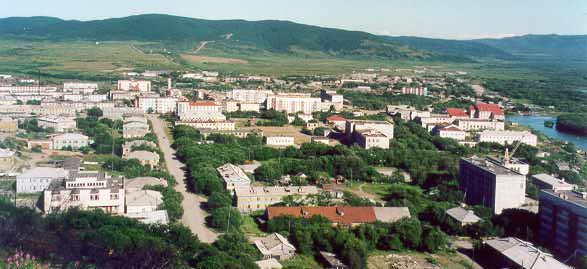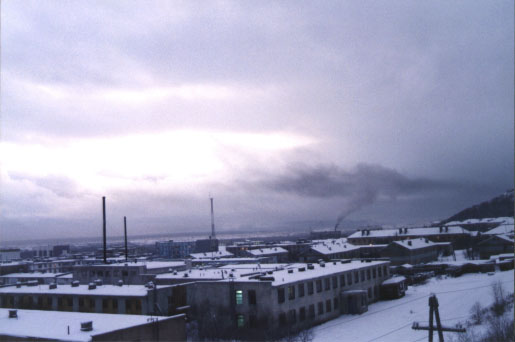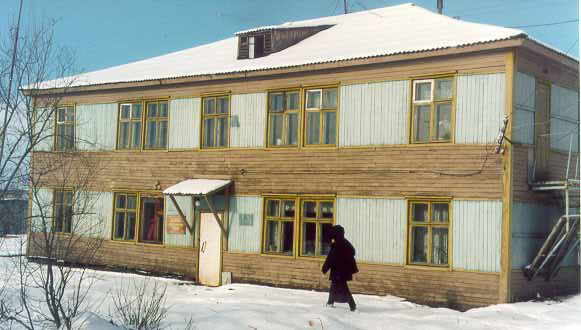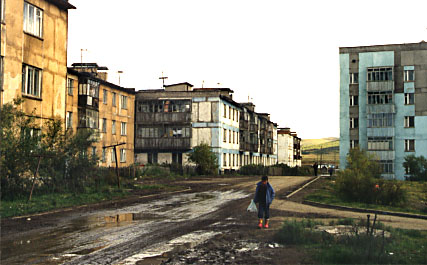Palana
Capital of the Koryak Autonomous Region
 This is Palana from a hill
to the northwest, looking easterly. I took this picture in mid August, 1997.
The sovkhoz is visible in the background, slightly to the right. This is where
most of the native population lives, in the worst housing. Many families still
do not have plumbing, or they have hot water only out of the radiator. Palana
is the capital and one of the three largest towns in the okrug. The population
is about 4,000 people. Although Palana still has a functioning sovkhoz, most
employment is in bureaucracy or other service organizations. Production consists
mostly of government and culture. Palana has the distinction of having the highest
prices for apartments on the Kamchatka Peninsula. While nice, three-room apartments
in Petropavlovsk can be found for US$25,000, this will buy you only a one or
two-room apartment in Palana. The only customer is the administration or large
companies like banks or fishing enterprises.
This is Palana from a hill
to the northwest, looking easterly. I took this picture in mid August, 1997.
The sovkhoz is visible in the background, slightly to the right. This is where
most of the native population lives, in the worst housing. Many families still
do not have plumbing, or they have hot water only out of the radiator. Palana
is the capital and one of the three largest towns in the okrug. The population
is about 4,000 people. Although Palana still has a functioning sovkhoz, most
employment is in bureaucracy or other service organizations. Production consists
mostly of government and culture. Palana has the distinction of having the highest
prices for apartments on the Kamchatka Peninsula. While nice, three-room apartments
in Petropavlovsk can be found for US$25,000, this will buy you only a one or
two-room apartment in Palana. The only customer is the administration or large
companies like banks or fishing enterprises.
 I took this picture from the window of
my apartment one evening in November 1995. I lived in the "doctors'" building
next to the hospital on the northwest corner of town. The doctors' building
was Palana's newest apartment building, built so the hospital staff could live
right next to the hospital. Unfortunately, the hospital was built on a swamp,
and the apartment building was built on a natural spring.
I took this picture from the window of
my apartment one evening in November 1995. I lived in the "doctors'" building
next to the hospital on the northwest corner of town. The doctors' building
was Palana's newest apartment building, built so the hospital staff could live
right next to the hospital. Unfortunately, the hospital was built on a swamp,
and the apartment building was built on a natural spring.
This lighted window in the foreground is in a student dormitory of the vocational-
technical secondary school. The smoke in the background is from the coal-fire
heating plant next to the Palana River. It burns low-grade coal from Sakhalin
Island and heats water, which is directed through big pipes running below and
above ground all over Palana. Buildings next to the heating plant are so hot
that people must leave the windows cracked, even in sub-freezing temperatures.
On the other hand, my building on the other end of town was barely heated by
tepid water running through the radiators.
The fall of 1995 was unusual for its great length. The first snowfall came
rather early, in the last week of September, but the winter freeze did not set
in until mid December. Snow fell and thawed, then froze, then thawed again,
resulting in water on ice. That is the scariest terrain for walking on a slight
incline.
The fall of 1997 was the opposite, with long spells of mild, warm weather.
I went berry collecting with a friend on October 25, and we got many ripe "brusnika,"
(cow berries) which don't mind nightly frosts. October was fairly dry, and in
November a large snowfall covered dry ground, making a clean transition from
dirt to snow without much mud. It snowed almost all of November and much of
December. We are expecting serious flooding this spring in June when most of
the snow has melted.
 The Palana Peduchilishche is the only organization of higher education
in the okrug. It trains teachers to work in preschool and K through 12 levels.
Graduates have also found jobs in various administrative organs of government
and even private companies. Foreign language instruction includes Koryak, Even,
Itel'men, English, and Japanese. If you are a native speaker of English or Japanese,
hold a B.A. or equivalent in any field, and are interested in teaching at the
Peduchilishche, email me (king@koryaks.net)
and I will tell you what to expect and how to contact the department of education.
The Palana Peduchilishche is the only organization of higher education
in the okrug. It trains teachers to work in preschool and K through 12 levels.
Graduates have also found jobs in various administrative organs of government
and even private companies. Foreign language instruction includes Koryak, Even,
Itel'men, English, and Japanese. If you are a native speaker of English or Japanese,
hold a B.A. or equivalent in any field, and are interested in teaching at the
Peduchilishche, email me (king@koryaks.net)
and I will tell you what to expect and how to contact the department of education.
 This is a view down Gil' Street, named for Alexander Gil', the founder
and first artistic director of the professional dance ensemble, Mengo. It is
one of two paved streets in Palana. Most people live in undersized apartments
in four or five-story, concrete apartment buildings. This is especially bad
for traditionally-minded Koryaks, who value contact with the earth and use a
fire and hearth as the ritual center of the household. Sprinkling a little vodka
on the burner of an electric stove just isn't the same as making an offering
to a fire.
This is a view down Gil' Street, named for Alexander Gil', the founder
and first artistic director of the professional dance ensemble, Mengo. It is
one of two paved streets in Palana. Most people live in undersized apartments
in four or five-story, concrete apartment buildings. This is especially bad
for traditionally-minded Koryaks, who value contact with the earth and use a
fire and hearth as the ritual center of the household. Sprinkling a little vodka
on the burner of an electric stove just isn't the same as making an offering
to a fire.
Compared to other towns and villages in the Region, Palana is very much the
social and political center. It not only houses the seat of government, with
attendant support of email access, a direct satellite link for fax, and reliable
electric power, it has several cultural facilities, as well. Several dance ensembles,
both professional and excellent amateurs, practice in Palana, and the
disco has live music about once a month. The Palana high school benefits from
an exceptional computer lab, with several IBM clones networked to a local server
and a laser printer and scanner. KamchatSvyazInform in Petropavlovsk-Kamchatsky
has set up a router connected to a couple modems in Palana, thus making Internet
access available to people in Palana, Lesnaya, and Wayampolka with a local call.
Back to Geography page.

Page Date: March 27, 2002
Alexander King, WEBMASTER (at) KORYAKS (dot) NET,
University of Aberdeen, Scotland, UK
 This is Palana from a hill
to the northwest, looking easterly. I took this picture in mid August, 1997.
The sovkhoz is visible in the background, slightly to the right. This is where
most of the native population lives, in the worst housing. Many families still
do not have plumbing, or they have hot water only out of the radiator. Palana
is the capital and one of the three largest towns in the okrug. The population
is about 4,000 people. Although Palana still has a functioning sovkhoz, most
employment is in bureaucracy or other service organizations. Production consists
mostly of government and culture. Palana has the distinction of having the highest
prices for apartments on the Kamchatka Peninsula. While nice, three-room apartments
in Petropavlovsk can be found for US$25,000, this will buy you only a one or
two-room apartment in Palana. The only customer is the administration or large
companies like banks or fishing enterprises.
This is Palana from a hill
to the northwest, looking easterly. I took this picture in mid August, 1997.
The sovkhoz is visible in the background, slightly to the right. This is where
most of the native population lives, in the worst housing. Many families still
do not have plumbing, or they have hot water only out of the radiator. Palana
is the capital and one of the three largest towns in the okrug. The population
is about 4,000 people. Although Palana still has a functioning sovkhoz, most
employment is in bureaucracy or other service organizations. Production consists
mostly of government and culture. Palana has the distinction of having the highest
prices for apartments on the Kamchatka Peninsula. While nice, three-room apartments
in Petropavlovsk can be found for US$25,000, this will buy you only a one or
two-room apartment in Palana. The only customer is the administration or large
companies like banks or fishing enterprises.  I took this picture from the window of
my apartment one evening in November 1995. I lived in the "doctors'" building
next to the hospital on the northwest corner of town. The doctors' building
was Palana's newest apartment building, built so the hospital staff could live
right next to the hospital. Unfortunately, the hospital was built on a swamp,
and the apartment building was built on a natural spring.
I took this picture from the window of
my apartment one evening in November 1995. I lived in the "doctors'" building
next to the hospital on the northwest corner of town. The doctors' building
was Palana's newest apartment building, built so the hospital staff could live
right next to the hospital. Unfortunately, the hospital was built on a swamp,
and the apartment building was built on a natural spring.  The Palana Peduchilishche is the only organization of higher education
in the okrug. It trains teachers to work in preschool and K through 12 levels.
Graduates have also found jobs in various administrative organs of government
and even private companies. Foreign language instruction includes Koryak, Even,
Itel'men, English, and Japanese. If you are a native speaker of English or Japanese,
hold a B.A. or equivalent in any field, and are interested in teaching at the
Peduchilishche,
The Palana Peduchilishche is the only organization of higher education
in the okrug. It trains teachers to work in preschool and K through 12 levels.
Graduates have also found jobs in various administrative organs of government
and even private companies. Foreign language instruction includes Koryak, Even,
Itel'men, English, and Japanese. If you are a native speaker of English or Japanese,
hold a B.A. or equivalent in any field, and are interested in teaching at the
Peduchilishche,  This is a view down Gil' Street, named for Alexander Gil', the founder
and first artistic director of the professional dance ensemble, Mengo. It is
one of two paved streets in Palana. Most people live in undersized apartments
in four or five-story, concrete apartment buildings. This is especially bad
for traditionally-minded Koryaks, who value contact with the earth and use a
fire and hearth as the ritual center of the household. Sprinkling a little vodka
on the burner of an electric stove just isn't the same as making an offering
to a fire.
This is a view down Gil' Street, named for Alexander Gil', the founder
and first artistic director of the professional dance ensemble, Mengo. It is
one of two paved streets in Palana. Most people live in undersized apartments
in four or five-story, concrete apartment buildings. This is especially bad
for traditionally-minded Koryaks, who value contact with the earth and use a
fire and hearth as the ritual center of the household. Sprinkling a little vodka
on the burner of an electric stove just isn't the same as making an offering
to a fire.